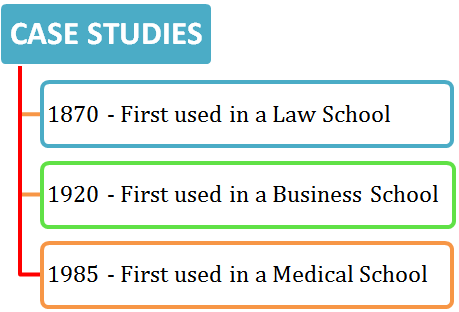The Case Method
A challenge any professional school (be it law, medical or a business school) faces is preparing its students to act in the real world. When students become professionals, they must diagnose the real world situation correctly, make the right decision and act accordingly. In this effort, these schools (led by Harvard) have found teaching via the case method to be the best. Any subject being taught is based around a case study followed by a question and answer session like the Socratic Method. Christopher Columbus Langdell, dean of Harvard Law School in 1870 is known as the pioneer of the case method. The case method was introduced in law school by him in 1870. By 1922, cases were widely adopted in business schools and found acceptance in medical schools as well.

A business or management case study is…?
A good case typically describes factual problems faced by a business or company (or is facing) and has no statement on the decision reached by the company. A case may have numerous solutions and students learn by participating in a discussion facilitated by the professor.
A typical case has on an average 10 to 20 pages of text, in addition to photos, illustrations and exhibits. At the end, the case has questions related to the problem or the subject being taught.
Researcher Robert K. Yin defines the case study research method as an empirical inquiry that investigates a contemporary phenomenon within its real-life context; when the boundaries between phenomenon and context are not clearly evident; and in which multiple sources of evidence are used
– Yin, R. K. (1984). Case study research: Design and methods. Newbury Park, CA: Sage
Case Studies are intended to provide wide-ranging information, management education, background information and leadership on the most relevant topics in business. Illustration from published and other sources, a case study is carefully designed to offer a highly practical resource for readers with all levels of experience. To assure quality and accuracy each case study is carefully reviewed. A case study is a written or recorded, detailed analysis of some targeted management issues, for the purpose of noting success or failure used as a benchmark for education, research, and/or planning. A case study is an in-depth exploration of one particular case (situation or subject) for the purpose of gaining understanding into the business/management issues being investigated.
Why are case studies used?
“The “real world” tends to produce complexity as the needs of stakeholders collide in a way that makes “fit”, rather than “optimization” the most relevant goal. Where fit is the goal, judgment is nearly always required. And the case method is well suited to presenting situations where judgment is needed.”
– Prof T. Grandon Gill, University of South Florida in his book in Nov 2011.
Writing a case study…
Various stages when writing a case study:
Stage 1 – Ideation, concept, and prototyping, and then
Stage 2 – Developing, qualifying, and commercializing.
Cardinal rule of case writing…
“Understand what type of case you are writing before you start writing…”- Prof. Gill
Types of Case Studies…
Three types of cases – Discussion, Walk-through and Exercise cases.
